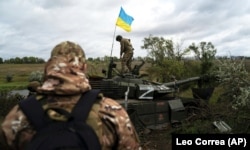Å“kosovo and the Continuing Sead Challenge
Russia has been sending in thousands of recently mobilized troops to reinforce the defense of the southern region of Kherson, where Kyiv's forces have been making major advances in their offensive to retake territory occupied by Moscow, the Ukrainian military said, as fresh Russian strikes on civilian targets were reported on October 21.
"Up to 2,000 mobilized Russians arrived in the temporarily captured Kherson region to replenish losses and strengthen units on the contact line," the General Staff of the Ukrainian Armed Forces said in a statement on October 21.
Live Briefing: Russia's Invasion Of Ukraine
RFE/RL's Live Briefing gives you all of the latest developments on Russia's ongoing invasion, Kyiv's counteroffensive, Western military aid, global reaction, Russian protests, and the plight of civilians. For all of RFE/RL's coverage of the war, click here.
"At the same time, the occupation authorities issued an order to prepare for the evacuation of the so-called banking institutions and Russian medical workers and teachers," the statement said.
Ukraine is trying to drive Russian forces in Kherson back east across the Dnieper River that bisects the country. Russian soldiers on the western bank, where the city of Kherson is located, are reportedly close to being cut off from supply lines and reinforcements.
President Volodymyr Zelenskiy's office said on October 20 that Ukrainian forces mounted 15 attacks on Russian military strongholds in the Kherson region in what appears to be the start of a major push to liberate the region and the strategic city of Kherson.
Russia's Defense Ministry, meanwhile, said the Kremlin's forces repelled Ukrainian attempts to advance with tanks on the Kherson villages of Sukhanove, Nova Kamyanka, and Chervoniy Yar.
Neither claim could be independently confirmed.
The city of Kherson, with a prewar population of about 284,000, was one of the first urban areas captured by Russia when it invaded Ukraine, and it remains the largest city it holds. The city is an important objective for both sides because of its key industries and a major port on the Dnieper River.
Moscow-installed officials have urged residents to evacuate and allow the military to build fortifications. Officials said 15,000 residents of an expected 60,000 had been relocated from the city and surrounding areas as of October 20.
Kherson is one of the four partially occupied Ukrainian regions that Russian President Vladimir Putin illegally seized following Kremlin-orchestrated referendums denounced as sham by Ukraine and the West.
Putin declared martial law in the Kherson, Luhansk, Donetsk, and Zaporizhzhia regions on October 19 in an attempt to assert Russian authority in the annexed areas as Moscow faced battlefield setbacks, a troubled troop mobilization, increasing criticism at home and abroad, and international sanctions.
In a video address to EU leaders gathered for a summit in Brussels on October 20, Zelenskiy warned that Ukraine suspects Russia has mined the dam and units of the Nova Kakhovka hydroelectric power plant on the Dnieper River in southern Ukraine, and if it were blown up, more than 80 settlements, including Kherson, would be in danger of flooding.
Zelenskiy said Ukrainian workers have been thrown out of the facility, leaving Russians in control. He asserted that Russia "has already prepared everything to carry out this terrorist attack."
He called for an international observation mission and the return of Ukrainian personnel to ensure the mines are removed from the dam and its units.
Zelenskiy's comment came two days after Vladimir Saldo, the Russian-appointed head of the Kherson region of Ukraine, announced an "organized, gradual displacement" of civilians from four towns on the right bank of the Dnieper River to the left side.
Saldo accused Ukrainian forces of planning to destroy the dam and also warned of "an immediate danger of flooding."
The Moscow-appointed deputy head of the Kherson region, Kirill Stremousov, encouraged people to cross over to the left bank of the Dnieper River and posted a video of a column of buses on Telegram.
Kyiv has denounced Moscow's move, calling it a "deportation" of Ukrainian civilians to Russia.
Over the past 10 days, Russia has also unleashed a wave of deadly attacks on Ukrainian civilian and energy infrastructure using artillery, air strikes, and Iranian-made suicide drones that destroyed 40 percent of the country's energy grid and prompted Kyiv to introduce rolling electricity restrictions for the first time since the start of the Russian invasion eight months ago.
WATCH: Ukrainian forces first got their hands on FH70 155-millimeter howitzers courtesy of Italy in May and received training in Estonia. RFE/RL journalists met with a frontline FH70 crew and watched them in action against Russian forces.
Early on October 21, a series of blasts rocked the Ukrainian cities of Kharkiv and Zaporizhzhya, authorities said.
Missiles hit an industrial facility in Kharkiv, Mayor Ihor Terekhov said. Separately, Kharkiv regional Governor Oleh Sinegubov said five people had been wounded.
No further details were immediately available about the Zaporizhzhua blasts.
Zelenskiy told EU leaders that the Russian attacks against civilians and infrastructure are aimed in part at provoking a new wave of migration of Ukrainians to EU countries.
"Russian terror against our energy facilities is aimed at creating as many problems as possible with electricity and heat for Ukraine this fall and winter and for as many Ukrainians as possible to go to your countries," he said.
This should be "answered immediately," primarily by more air-defense systems sent to Ukraine, the president said, speaking by video conference from Kyiv.
"We must do everything possible to make it completely impossible for Russia to destroy our energy system with missiles and drones," Zelenskiy said in the virtual speech, calling on Ukraine's partners to provide systems "to create a truly reliable air shield."
With reporting by Reuters, AFP, dpa, and BBC
cooneythujered1941.blogspot.com
Source: https://www.rferl.org/a/kosovo-serbia-border-crossing-blocked-tensions/31967812.html

0 Response to "Å“kosovo and the Continuing Sead Challenge"
Post a Comment